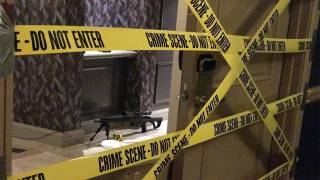Surveillance Footage of Las Vegas Shooter Paddock Released by NYT, Brought in 21 Bags to Mandalay Bay Over Several Days
Sometimes we see him as other hotel guests would have seen him: as the tall gambler intent on the video poker machine across the casino floor, or as the customer standing in line in front of you at the gift shop, buying snacks, or as the guy you briefly glance at as he waits for you to get off the elevator — polite, unhurried, unmemorable.
Sometimes we see him as the employees would have seen him, as the casually dressed V.I.P. with the many suitcases who jokes with bellhops, chats with valets and gives out tips along with handshakes. And sometimes we see him as only the surveillance cameras saw him — riding the elevator alone.
Within a few days, he would use the arsenal he had moved upstairs in those suitcases to shoot and kill 58 people from his 32nd-floor suite at the Mandalay Bay Resort and Casino in Las Vegas.
These were Stephen Paddock’s final movements in the days before he opened fire from his hotel suite on Oct. 1: an apparently relaxed solo vacation that, as surveillance footage obtained by The New York Times from MGM Resorts makes clear, was actually the methodically planned prelude to a massacre.
Rarely are investigators or the public able to track the preparations of a mass gunman in such molecular detail. Yet for all the material the footage offers about the who, the what, the where, the when and the how, we are no closer to the why.
Watching the footage, nearly six months later, is a kind of compulsive ghost-hunting. In the antiseptic stare of the surveillance camera, even the most ordinary interactions are deformed, made weird only by what we know now. It is unnerving because it ends in the deadliest mass shooting in modern American history. It is unnerving because even with his every movement laid out, the grotesquely composed protagonist of this film gives away nothing.
The faces of hotel guests and staff are blurred to preserve their privacy, reducing them to smudges that crisscross the screen at random. Mr. Paddock is the only person who appears throughout, the Waldo whose distinctive frame and faintly lopsided gait our eyes quickly learn to seek out in every frame. The clips begin when he appears and end after he leaves. The other people are little more than a backdrop.
Except that some of them may become his victims. And some are already his unwitting accomplices.
Over and over in the clips, Mr. Paddock is seen leaving the Mandalay Bay for his home in Mesquite, returning with a dark minivan loaded with suitcases. Over and over, valets take his keys; over and over, bellhops stack his luggage on gold carts, helping him transport at least 21 bags over the course of seven days. As they take the service elevator upstairs, Mr. Paddock chats with them. He cracks a joke. He tips.
They have no idea that the suitcases they are so conscientiously carrying are full of guns and ammunition.
Mandalay Bay employees are virtually the only people with whom Mr. Paddock interacts in the surveillance footage. He checks in at the V.I.P. desk, eats alone at the resort’s sushi restaurant, makes snack runs to the gift shop and gambles at the high-stakes video poker machines. Casino hosts greet him as a regular. Security cameras capture him with arms aloft, celebrating a $1,000 win.
But his movements are otherwise sedate, deliberate, unobtrusive, so much so that when he raises a hand to scratch his face in the elevator at one point, the extra movement registers as significant, even sinister.
Toward the end of the footage, two guests carrying shiny plastic inner tubes get off the elevator, padding out in flip-flops. Mr. Paddock pauses to let them off, then gets on.
It is the afternoon of Sept. 30. They seem to be on their way to the pool. He is on his way upstairs, where his guns await.






















